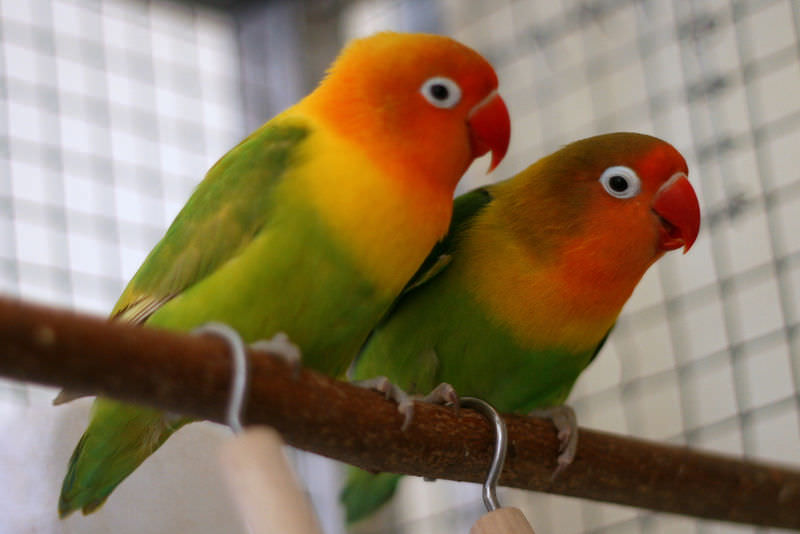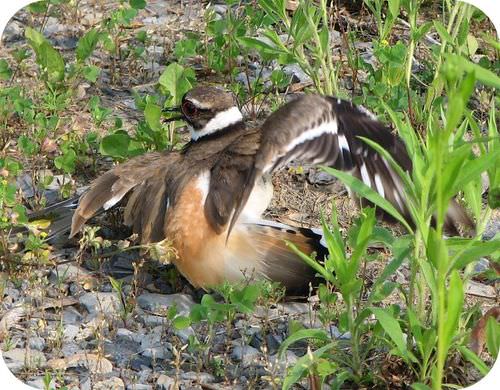8.6: Reproductive Behavior
- Page ID
- 2990

Why do these birds pair up?
These birds are pairing up so that they can produce offspring. Many birds are monogamous, keeping the same mate for an entire season. In some species, they even stay paired for their entire life.
Mating Behavior and Defending Territory
Some of the most important animal behaviors involve mating. Mating is the pairing of an adult male and female to produce young. Adults that are most successful at attracting a mate are most likely to have offspring. Traits that help animals attract a mate and have offspring increase their fitness. As the genes that encode these traits are passed to the next generation, the traits will become more common in the population.
Courtship Behaviors
In many species, females choose the male they will mate with. For their part, males try to be chosen as mates. They show females that they would be a better mate than the other males. To be chosen as a mate, males may perform courtship behaviors. These are special behaviors that help attract a mate. Male courtship behaviors get the attention of females and show off a male’s traits. These behaviors are often observed as direct competition between males.
Different species have different courtship behaviors. One example is a peacock raising his tail feathers. The colorful peacock is trying to impress females of his species with his beautiful feathers. Another example of courtship behavior in birds is the blue-footed booby. He is doing a dance to attract a female for mating. During the dance, he spreads out his wings and stamps his feet on the ground. You can watch the following video of a blue-footed booby doing his courtship dance at: http://www.youtube.com/watch?v=oYmzdvMoUUA.
Courtship behaviors occur in many other species. For example, males in some species of whales have special mating songs to attract females as mates. Frogs croak for the same reason. Male deer clash antlers to court females. Male jumping spiders jump from side to side to attract mates.
Courtship behaviors are one type of display behavior. A display behavior is a fixed set of actions that carries a specific message. Although many display behaviors are used to attract mates, some display behaviors have other purposes. For example, display behaviors may be used to warn other animals to stay away, as you will read below.
Caring for the Young
In most species of birds and mammals, one or both parents care for their offspring. Caring for the young may include making a nest or other shelter. It may also include feeding the young and protecting them from predators. Caring for offspring increases their chances of surviving. Birds called killdeers have an interesting way of protecting their chicks. When a predator gets too close to her nest, a mother killdeer pretends to have a broken wing. The mother walks away from the nest holding her wing as though it were injured (Figure below). The predator thinks she is injured and will be easy prey. The mother leads the predator away from the nest and then flies away.

In most species of mammals, parents also teach their offspring important skills. For example, meerkat parents teach their pups how to eat scorpions without being stung. A scorpion sting can be deadly, so this is a very important skill. Teaching the young important skills makes it more likely that they will survive. Notice that, compared to other types of animals, birds and mammals have relatively few offspring.
Defending Territory
Some species of animals are territorial. This means that they defend their area. The area they defend usually contains their nest and enough food for themselves and their offspring. A species is more likely to be territorial if there is not very much food in their area. Having a larger territory could mean more prey or food.
Animals generally do not defend their territory by fighting. Instead, they are more likely to use display behavior. The behavior tells other animals to stay away. It gets the message across without the need for fighting. Display behavior is generally safer and uses less energy than fighting. Male gorillas use display behavior to defend their territory. They pound on their chests and thump the ground with their hands to warn other male gorillas to keep away from their area. The robin displays his red breast to warn other robins to stay away (Figure below).

Some animals deposit chemicals to mark the boundary of their territory. This is why dogs urinate on fire hydrants and other objects. Cats may also mark their territory by depositing chemicals. They have scent glands in their face. They deposit chemicals by rubbing their face against objects.
Summary
- Males of some species may perform courtship behaviors, special behaviors that help attract a mate.
- Some species of animals are territorial and defend their area.
Explore More
Use the resources below to answer the questions that follow.
Explore More I
- Behavior on a Sage Grouse Lek at http://www.youtube.com/watch?v=QYMHbFUTgAY (1:15)
- What is a lek? What sort of behavior is seen in a lek?
- When do sage grouse (Centrocercus urophasianus) put on the most weight? How does this affect their reproductive success?
Explore More II
- Elk Fighting in River at http://www.youtube.com/watch?v=GUQcMZLZpx8 (2:45)
- Notice the male elk (Cervus canadensis) which enters the video at the 2:05 mark. What do you think it is trying to do? Do you think its behavior helps or hurts the survival of elk in Yellowstone National Park?
- What sort of behavior are the male elk displaying?
Review
- What is a courtship behavior. Give an example.
- Give an example of display behavior exhibited by a territorial animal.

